Top 10 Exercises For Football Strength and Speed
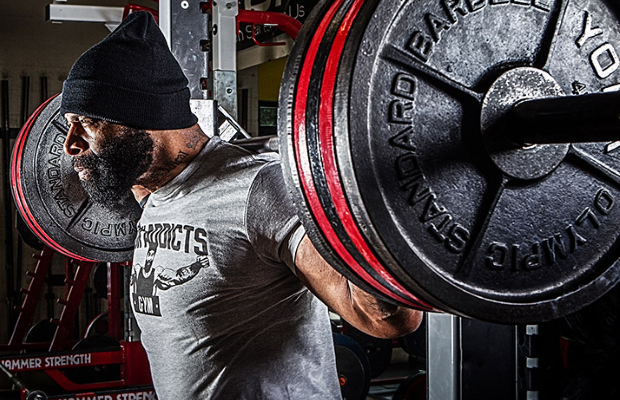
Editor’s Note: Although this article was posted over five years ago, it has become by far one of most popular. Due to its relevance, we regularly re-post it.
Way too many football players and strength coaches develop favorite lifts (usually one’s they’re good at) and stick to them no matter what. I’ve run into guys I trained with a decade ago and they are still doing the same workouts! I don’t mean the same philosophy; I mean the actual same football workout! Same exercises, sets, reps and sometimes, sadly, weights. While we need to rotate exercises constantly to avoid accommodation, we can’t just add any-old exercise and hope for the best. Plus, often, the exercises we hate the most are the ones that do us the most good. Many guys hate movements like lunges, but, if you want to get faster for football, you need to do them.
Another way to get the thrill of the rush of football is sports betting. Try NJ Sport betting sites, when online sports-books are now legal. Or for Polish fans try automaty 777.
Here are the top 10 Exercises for to Get Faster and Stronger for Football. Add them to your rotation and work ’em hard.
1. Deadlifts – Deadlifts are the King Maker…they might be more responsible for building football speed and strength than any other exercise.
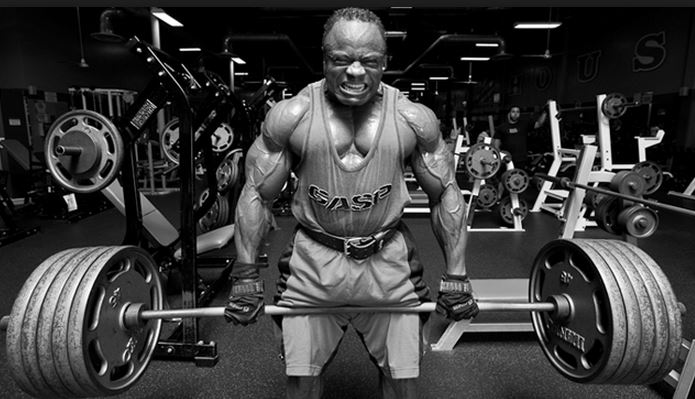
Photo: Deadlift Workouts
Deadlifts are ultra-important for several reasons:
- They build tremendous starting strength. Many football players are woefully lacking in the ability to get explosive and apply strength quickly.
- Deads strengthen the Posterior Chain; building power and strength in the hamstrings, glutes, calfs, and the entire back (the muscles responsible for getting you faster for football).
- Deadlifts, like Squats, build insane strength in the hips; the seat of power for football.
- They build slabs of muscle. Nothing will make you grow from your calfs to your traps like heavy Deadlifts.
- The Deadlift can be extremely useful for injury prevention. Some believe that the moderate to high hamstring activity elicited during the deadlift may help to protect the Anterior Cruciate Ligament during rehab.
Deads can be used as Max Effort, Dynamic Effort or moderate rep exercise. The classic 5 x 5 protocol applied to the DL can put more muscle on your frame than most other exercises combined.
2. Box Squats – Box Squats and Box Front Squats are essential for building tremendous leg strength and explosiveness while taking almost all stress off the knees. They are the cornerstones (along with deadlifts) of any football strength training program that can make a player stronger and faster for football. 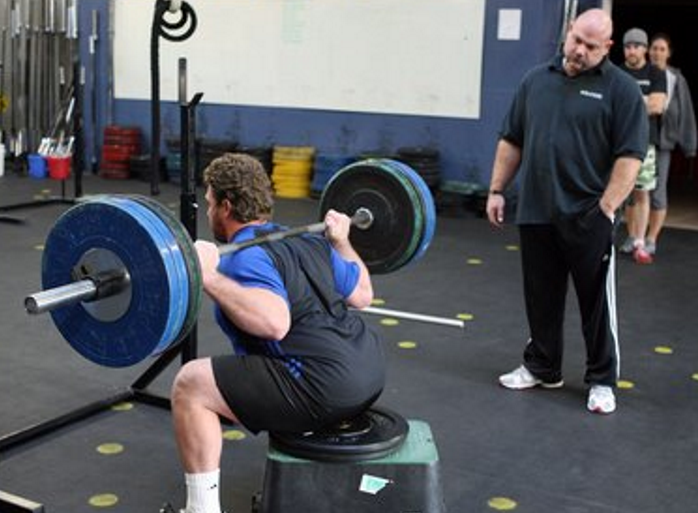 Louie Simmons of Westside Barbell Club, who’s club has done more to popularize Box Squats than anyone else in America describes the benefits of Box Squatting in one of his articles:
Louie Simmons of Westside Barbell Club, who’s club has done more to popularize Box Squats than anyone else in America describes the benefits of Box Squatting in one of his articles:
Many trainers have found that a great deal of flexibility can be developed while box squatting: by going lower than normally possible, and by using a wider stance. You can isolate all the correct squatting muscles by sitting extremely far back on the box. By sitting back on the box to the extent that your shins are positioned past vertical, the glutes, hips, hamstrings, spinal erectors, and abs are totally pre-stretched and overloaded simultaneously, producing a tremendous stretch reflex. Box Squats eliminate many of the problems encountered when doing traditional squats.
Gone are the knee problems associated with the knees traveling way past the toes. You are also limiting the stretch reflex, so Box Squatting becomes much like a Deadlift in it’s ability to build explosive strength. Box Squats also teach an athlete to stay tight and explode up using the hips, hams, and glutes. This is essential for any sport that requires running or jumping…which is pretty much all of them! They are key for building football speed and strength. Some other huge advantages of Box Squatting include:
- Less soreness than traditional squats, allowing you to recover faster and train more often
- No guessing on depth. Set the box to where you want to go and simply sit back on it.
- Box Squats can increase real-world flexibility. If you widen the stance, push the knees out, and descend under control, you will develop excellent mobility and flexibility in the legs and hips.
- Build tons of strength in the glutes and hips – critical to blocking and tackling.
Use Box Squats for either Max Effort or Dynamic Effort training. If you go heavy, either work up to a max set of 1 – 4, or do multiple sets of low reps If using the Box Squat as a speed exercise, it’s best to use resistance bands or chains and go for 12 sets of 2 reps with 60 seconds rest. This will all be explained in the workouts section where you will see a living, breathing example of sets and reps for the Box Squat (and all other exercises).
3. Clean & Jerk – A few years back Olympic Lift-only training programs were all the rage. Then, they fell out of favor and on came the anti-Olympic lifting brigade. As usual, and over-reaction short term and an underreaction long term.
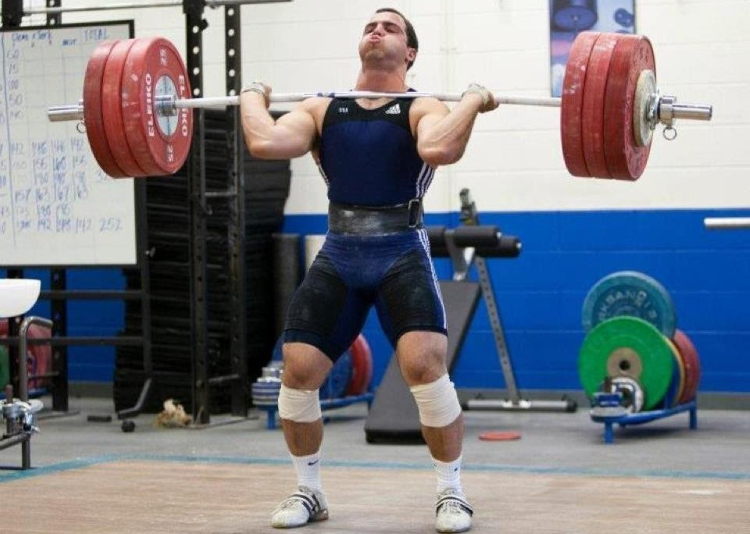
The truth is that the O-lifts are still extremely helpful for football players and, should be included in your football strength workouts. The undisputed king of the O-lifts for athletics is the Clean and Jerk. It’s a lift that builds toughness, identifies weaknesses, and requires strength, power and determination. All the traits an athlete needs!
The C&J is similar to the Deadlift in it’s ability to point out weaknesses. Lifting a heavy bar from the ground to overhead requires strength in the entire posterior chain, plus the abs, shoulders and triceps. If any one of those areas are weak, you will miss the lift. Some say they are hard to teach but I can get an athlete doing cleans in one session. Remember, the C&J (and just about any other exercise) does not have to be done with a barbell alone.
Using sandbags, barrels, dumbbells, kettlebells, a Stone Trainer, a thick bar or a Log is an excellent way to build real-world athletic strength and get around the technique issue. This kind of lifting can be used to build brute strength and also excellent conditioning and mental toughness. Grabbing a pair of DB’s and doing high rep or timed sets of the C&J is an excellent conditioning tool. I picked up this idea from an old Louie Simmions article and it’s helped me and many of my athletes get in top shape, even when the weather prevents us from going outside. Plus, it really helps build focus and mental toughness. If you are using the C&J for strength, stick to singles and doubles. If you want conditioning, go with higher reps or time your sets.
4. Box Front Squats – Just as with the O-lifts, people went crazy with the training of the posterior chain. Yes, it’s supremely important, but many athletes and coaches went overboard, completely disregarding the front of the body.
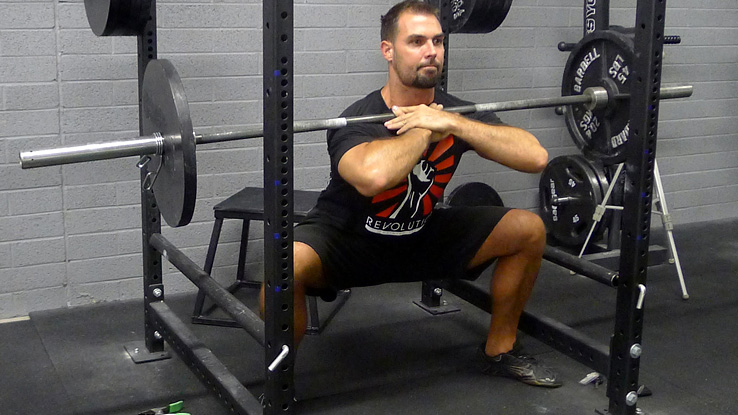
An athlete needs strong quads for sprinting, jumping, and driving another human out of their way. Many feared training the quads at all would lead to them overpowering the hamstrings. This can happen when the hams are under-trained, but we can’t allow the quads to become weak either. Any imbalance, either way, will lead to decreased performance and possible knee injuries. I always loved Front Squats and believe they might be better than Back Squats for many football players, especially lineman.
Having the load held on the front of the body will build tremendous strength in the core, and the entire motion is very similar to the motion of blocking. But, most guys I’ve seen can’t Front Squat to save their life. They have more bad habits than Artie Lange. They push the knees way over the toes, don’t sit back, and fall forward. Enter the Box Front Squat. Using boxes at different heights, and a soft box, allows the athlete to sit back, stay fairly upright and drive through the floor, rather than just squatting up and down. It does place some of the stress on the glutes and hams, but leaves plenty of work for the quads as well.
It is especially helpful to do your Box FS with bands or chains. This will help build amazing driving ability and the power to simply run through people. Football is not the only contact sport…in soccer, basketball and hockey, your ability to get the enemy out of your way en route to the goal is essential. Keep reps low when Front Squatting. Use multiple sets of 1 – 4 reps, or use it as your Max Effort movement and work up to a heavy single.
5. RDL – Romanian Deadlifts are an excellent assistance exercise for Deadlifts and Squats. They build muscle and power in the hamstrings and glutes and also hit the lower back quite well.
The RDL is great for athletes because it is performed in the stance very similar to the “ready position” used is so many sports (hips down, knees bent, flat back…think a Linebacker or the position of the body pre-jump). The romanian Deadlift is such an excellent to get you faster for football that it should be included in the majority of your football workouts.
For many athletes, the RDL is a far superior exercise to the Straight Leg Deadlift. For anyone with a long torso, the SLDL can become a lower-back exercise and damn-near neglect the hamstrings. But, because of the hip position (traveling backwards) and the intense pre-stretch of the hamstrings, the RDL is much better at working the PC. RDL’s can be done as your Max Effort movement, especially if you do them in the Rack. RDL’s in the rack.
But, their main strength lies in using them as an assistance exercise for Squats and Deads. If using them as an assistance, go for 3 – 5 sets of 3 – 8 reps.
6. Rows – Too many football players and lifters focus way too much on the pressing exercises and neglect the muscles of the back. This will lead to injuries like rotator cuff tears, pec tears, and shoulder impingements. Worst than that it will also lead to a crappy bench press.
There is about a billion row variations, so pick 2 or three and put them in your training program. You can go heavy or for reps, or both. If you’ve been neglecting your back, you should start off by doing twice as much back work as chest/pressing work!
7. Side Lunges – Most of us simply do not do enough training on lateral movements, which I find odd because so much of sports is played while moving from side-to-side.
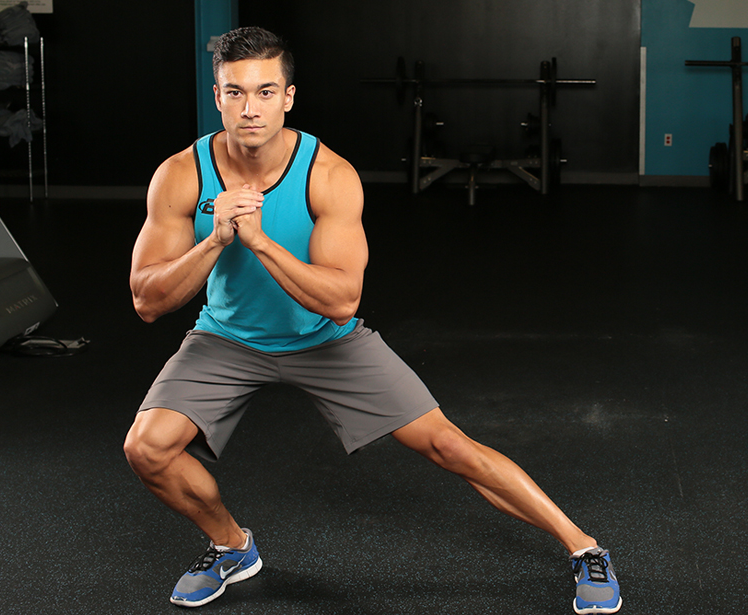
There are several reasons why most athletes avoid movements like Side Lunges:
- Ego: Less weight (much less!) will have to be used, especially at first.
- Pain: Side Lunges, even with light weight, have the potential to leave you with damn-near injury-like soreness, especially if you aren’t used to doing them
- Ego, again: You’ll never be able to slap on endless 45’s on this exercise, so most people will just avoid the hit to their pride.
- Lateral movements are key to building football game speed.
8. Dumbbell Incline – I’m hated for saying this, but I believe the Dumbbell Incline is a much better movement for athletes than the Bench. Obviously, the bench press is a great exercise, but when it comes to athletes, not Powerlifters, the Incline rules.
The DB Incline much more closely mimics the path taken by the arms in many athletic movements such as blocking, punching, and in many wrestling moves. The incline is also much better at developing the all-important shoulder girdle. It’s a nice compromise between the Overhead Press and the Bench, allowing an athlete to hammer the shoulders, pecs and triceps. Adding the Dumbbell Incline to your football strength program is an excellent idea, especially for lineman and linebackers.
For those with shoulder problems, Incline can be a life-saver. When I had rotator cuff problems, benching even super light weights felt like I was being stabbed in the front delts! But, I was able to continue doing Inclines as heavy as I could handle. When I fixed my shoulder problems, I returned to the bench and lost very little progress. The DB Incline is also incredibly versatile; you can use it for Timed Sets, High reps, moderate reps, or you can go super heavy and treat it as a Sub-Max movement. If you’d really like a challenge, try doing a 1-Arm DB Incline, now that’s real “core” training!
9. Sandbags – Lifting and carrying sandbags are excellent ways to “bridge” the gap between the weightroom and the playing field. Sandbags are excellent strength and conditioning tools for wrestlers, football players, and fighters. They will also help with just about any other sport that requires strength, speed, and stamina.
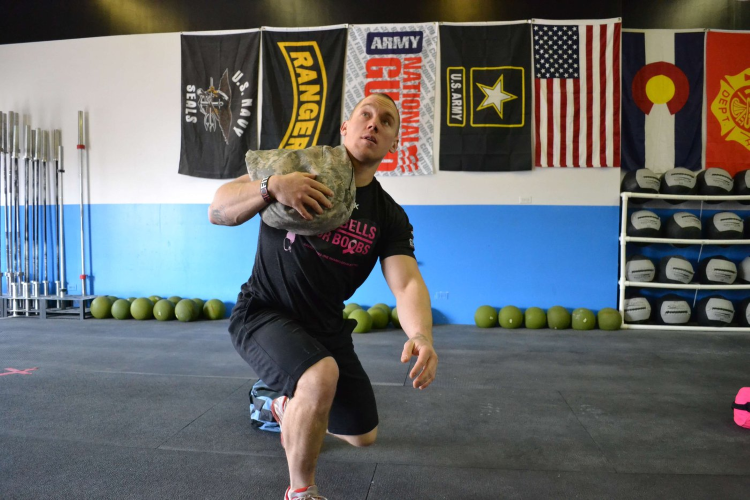
Sandbags shift and fight you every inch of the way. They never relent. Picking up and carrying or shouldering a sandbag feels a lot like wrestling a live opponent. While all the work in the weightroom helps build max strength and speed, using sandbags will be an excellent compliment to your heavy training. There’s a lot of great resources on sandbag training, but I recommend you check out Josh Henkin’s sandbag training course.
10. Prowler – The Prowler owns all when it comes to conditioning for football. It can be pushed and pulled for time, distance or speed. It can be loaded heavy or light. See where I’m going with this? 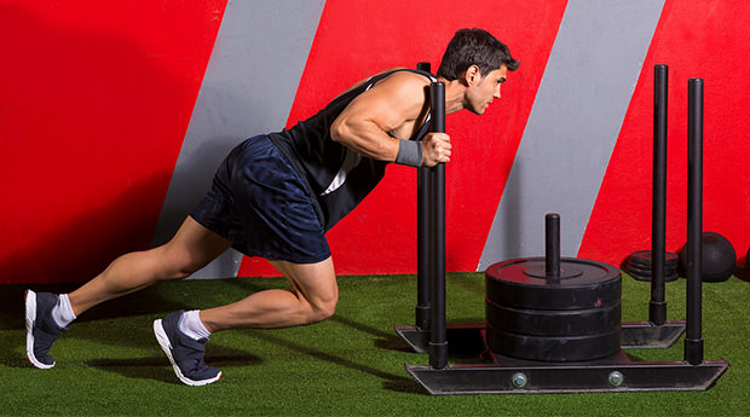 The Prowler is also great because you can use it laterally, which as I said earlier, most athletes neglect. So much of sports is played moving laterally, yet training that way is ignored.
The Prowler is also great because you can use it laterally, which as I said earlier, most athletes neglect. So much of sports is played moving laterally, yet training that way is ignored.
Use the Prowler as a finisher or on a non-lifting day as a way to condition. Because of the lack of eccentric movement, the Prowler will not cause much soreness, which is a huge advantage for athletes. One of the biggest issues when designing a training program for an athlete is how to give strength, speed and conditioning their proper due without compromising any of the elements. Using the Prowler is simple, go light for time for recovery and GPP work. Go a little heavier for sprints and go heavy for strength work.
For more football workouts and drills, check out these blocking sleds from Anytime Sports Supply.
Steven Morris is a Personal Trainer and Strength Coach in the Philadelphia and South Jersey areas and owner of Explosive Football Training. He has been lifting weights for over 15 years and has been helping people achieve their fitness and strength goals for over a decade.